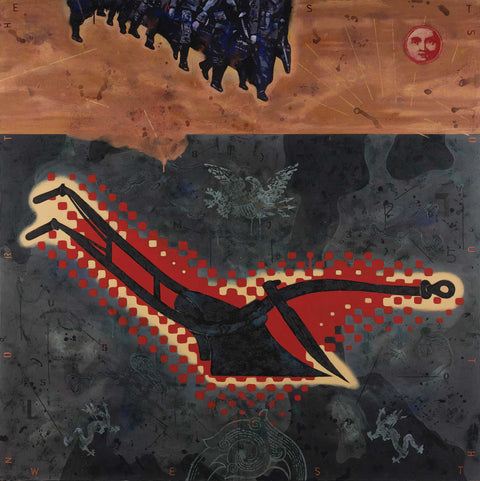Baiju Parthan
Born in Kerala in 1956, Baiju Parthan has degrees not only in Painting, but also in Botany and Comparative Mythology, factors that correspond to his interest in and use of intermedia in his works. Parthan began as an engineer but was drawn into the world of art in 1974. He completed his Bachelor’s Degree in Fine Arts (Painting), from the Goa College of Art, Goa in 1983.
Baiju Parthan is an inter-media artist, working simultaneously with traditional media of painting and digital technology-based installation art. He is one of the early exponents of new media art and mediatic-realism in the Indian contemporary art scene. His work presents worldviews built upon differing ideologies that are in collision and transforming each other, and the resulting ontological fallout felt and lived by us all. Parthan’s chosen vocabulary consists of arcane symbols, found imagery, as well as contemporary photography and computer graphics woven together to create paintings, prints and videos which reveal a dense multi layered phenomenological landscape. His work in the digital realm consists mainly of explorations into the constantly mutating interstice where the virtual and real bleed into each other.
Initially, Baiju Parthan resisted a career as an artist. "In Kerala," he explains, "you are what your work is. And in Kerala's Communist schema, the artist is at the lowest rung of society." Parthan got drawn into the world of art in 1974, when he stumbled onto a book detailing the history of Western art. "Painting gave me self-worth. In that pictorial space, I was king. I began to define myself through this act of painting: It was the only place where I could 'be'." Excited by the prospect of studying art, Parthan went to Goa and enrolled in a five-year course in the fine arts. Parthan's course, running from 1978-1983, overlapped with the final influx of Westerners coming to Goa in search of enlightenment. There were Germans, Brits, Italians - all sorts of people, mostly from Europe. I came across these hippies, and became exposed to a whole range of alternate world views," says Parthan, adding "I had always thought that reality is one unified thing."
Parthan began to study the Indian mystical arts, exploring tantra, ritual arts, and Indian mythology. Simultaneously, Western art continued to exert an influence. Parthan names Larry Rivers, Miro, and the Cubist painters as important models.
In the early 1980s, Parthan decided to quit painting. "I felt like a missionary for Western art," he explains. Instead, he enrolled in a course on comparative mythology at Bombay University, and began working as a writer and illustrator. He returned to painting in the early 1990s, when he began to explore the imagery of mandalas and Tibetan tangas. These traditional subjects were balanced by his reading in post-modern theorists. The latter enabled him to "recontextualize things from my immediate environment. The post-modern theorists have accepted the localization of reality. We're now reconciled to the idea of an individual reality. Art is about local realities. Personally, I live in a post-colonial concept of space. The world exists as a flux."
In 1995, Parthan began to study computers, learning hardware engineering, building his own machine, and creating programs. "I didn't want to be afraid of technology," says Parthan. "The machine has become the Other for humans, and it raises philosophical issues that we have to grapple with." Parthan is especially interested in the influence of technology on religious beliefs, the implications of genetic engineering, and the possibilities of post-humanism (i.e. the development of symbiotic relations between men and machines).
He has had a number of solo and group exhibitions, including ‘Recursor’, Gallery OED, Kochi, in 2012; ‘Milljunction: Paintings and Photo works by Baiju Parthan’, Aicon Gallery, New York, in 2010; ‘Liquid Memory + Rant’, New Media Installation at Vedehra Art Gallery, New Delhi in 2007
Parthan has also received many awards, including the “Goa Lalit Kala Academy Award for Artist of the Year,” Goa, in 1981.
His exhibit with us is titled Iron Plough Harvest, an acrylic on canvas made in 2007.




